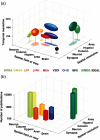Improving voltage-sensitive dye imaging: with a little help from computational approaches
- PMID: 28573154
- PMCID: PMC5438098
- DOI: 10.1117/1.NPh.4.3.031215
Improving voltage-sensitive dye imaging: with a little help from computational approaches
Abstract
Voltage-sensitive dye imaging (VSDI) is a key neurophysiological recording tool because it reaches brain scales that remain inaccessible to other techniques. The development of this technique from in vitro to the behaving nonhuman primate has only been made possible thanks to the long-lasting, visionary work of Amiram Grinvald. This work has opened new scientific perspectives to the great benefit to the neuroscience community. However, this unprecedented technique remains largely under-utilized, and many future possibilities await for VSDI to reveal new functional operations. One reason why this tool has not been used extensively is the inherent complexity of the signal. For instance, the signal reflects mainly the subthreshold neuronal population response and is not linked to spiking activity in a straightforward manner. Second, VSDI gives access to intracortical recurrent dynamics that are intrinsically complex and therefore nontrivial to process. Computational approaches are thus necessary to promote our understanding and optimal use of this powerful technique. Here, we review such approaches, from computational models to dissect the mechanisms and origin of the recorded signal, to advanced signal processing methods to unravel new neuronal interactions at mesoscopic scale. Only a stronger development of interdisciplinary approaches can bridge micro- to macroscales.
Keywords: advanced signal processing; biophysical model; computational models; voltage-sensitive dye imaging.
Figures





Similar articles
-
Mammalian cortical voltage imaging using genetically encoded voltage indicators: a review honoring professor Amiram Grinvald.Neurophotonics. 2017 Jul;4(3):031214. doi: 10.1117/1.NPh.4.3.031214. Epub 2017 May 4. Neurophotonics. 2017. PMID: 28491906 Free PMC article. Review.
-
The relationship between voltage-sensitive dye imaging signals and spiking activity of neural populations in primate V1.J Neurophysiol. 2012 Jun;107(12):3281-95. doi: 10.1152/jn.00977.2011. Epub 2012 Mar 14. J Neurophysiol. 2012. PMID: 22422999 Free PMC article.
-
Linear model decomposition for voltage-sensitive dye imaging signals: application in awake behaving monkey.Neuroimage. 2011 Jan 15;54(2):1196-210. doi: 10.1016/j.neuroimage.2010.08.041. Epub 2010 Aug 26. Neuroimage. 2011. PMID: 20800686
-
Voltage-sensitive dye imaging: Technique review and models.J Physiol Paris. 2010 Jan-Mar;104(1-2):40-50. doi: 10.1016/j.jphysparis.2009.11.009. Epub 2009 Nov 10. J Physiol Paris. 2010. PMID: 19909809 Review.
-
Imaging the Dynamics of Neocortical Population Activity in Behaving and Freely Moving Mammals.Adv Exp Med Biol. 2015;859:273-96. doi: 10.1007/978-3-319-17641-3_11. Adv Exp Med Biol. 2015. PMID: 26238057 Review.
Cited by
-
Explainable Artificial Intelligence for Neuroscience: Behavioral Neurostimulation.Front Neurosci. 2019 Dec 13;13:1346. doi: 10.3389/fnins.2019.01346. eCollection 2019. Front Neurosci. 2019. PMID: 31920509 Free PMC article.
-
Functional ultrasound imaging of deep visual cortex in awake nonhuman primates.Proc Natl Acad Sci U S A. 2020 Jun 23;117(25):14453-14463. doi: 10.1073/pnas.1916787117. Epub 2020 Jun 8. Proc Natl Acad Sci U S A. 2020. PMID: 32513717 Free PMC article.
-
Sequentially activated discrete modules appear as traveling waves in neuronal measurements with limited spatiotemporal sampling.Elife. 2024 Mar 7;12:RP92254. doi: 10.7554/eLife.92254. Elife. 2024. PMID: 38451063 Free PMC article.
-
Disparate nonlinear neural dynamics measured with different techniques in macaque and human V1.Sci Rep. 2024 Jun 8;14(1):13193. doi: 10.1038/s41598-024-63685-6. Sci Rep. 2024. PMID: 38851784 Free PMC article.
-
Evaluation and Optimization of Methods for Generating High-Resolution Retinotopic Maps Using Visual Cortex Voltage-Sensitive Dye Imaging.Front Cell Neurosci. 2021 Sep 21;15:713538. doi: 10.3389/fncel.2021.713538. eCollection 2021. Front Cell Neurosci. 2021. PMID: 34621157 Free PMC article.
References
LinkOut - more resources
Full Text Sources
Other Literature Sources

